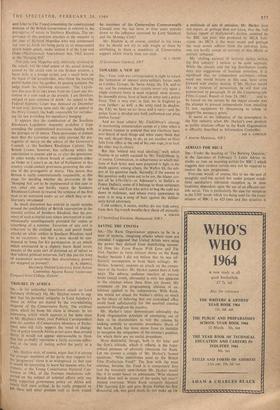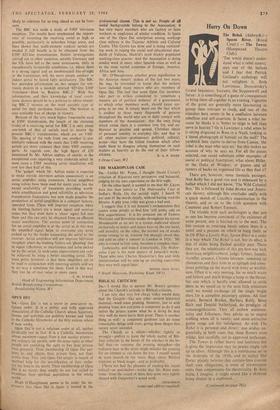AERIALS FOR BBC-2 SIR,—Under the heading of 'The Burning Question,'
in the Spectator of February 7, Leslie Adrian in- cludes an item on receiving aerials for BBC-2 which suggests that outdoor aerials may not be required to receive the new programme.
Everyone would, of course, like to see the end of unsightly roof-top aerials but under present condi- tions satisfactory television reception is, in most locations, dependent upon the use of an efficient out- side aerial. This is particularly the case for reception in the UHF bands which are being used for the trans- mission of BBC-2 on 625-lines and this situation is likely to continue for as long ahead as can be fore- seen.
The BBC has made a study of UHF television reception. The results have emphasised the import- ance of mounting the receiving aerial as high as possible, particularly in suburban fringe areas, and have shown that multi-element outdoor aerials are needed if full benefit is to be obtained from the UHF 625-line transmissions. Similar investigations carried out in other countries, notably Germany and the US, have led to the same conclusions. Only in exceptionally favourable conditions, i.e. where there is a strong signal and an unobstructed line-of-sight to the transmitter, will the more simple outdoor or indoor aerial be found fully satisfactory. The BBC has provided information on this, subject for tele- vision dealers in a booklet entitled '625-line UHF Television—How to Receive BBC-2.' With this information, and their knowledge of local condi- tions. dealers should be in a position to advise intend- ing BBC-2 viewers on the most suitable type of aerial for their particular location. The booklet is also available free of charge to viewers.
Because of the very much higher frequencies used in UHF transmission,, the length of the elements (rods) of a receiving aerial for BBC-2 is only about one-tenth of that of aerials used to receive the present BBC-I transmissions, which are on VHF. The spacing of the rods from one another is also similarly reduced with the result that UHF receiving aerials are more compact than their VHF counter- parts. As regards cost, the high figure of £20 mentioned by Mr. Adrian applies, of course, to the exceptional case requiring a very elaborate aerial. In most cases a UHF receiving aerial installation will cost less than half of this.
The 'gadget' which Mr. Adrian states is expected to make outside television aerials unnecessary is an aerial amplifier using transistors. Aerial amplifiers using valves have been used for many years but the recent availability of transistors providing worth- while amplification and good reliability at television transmission frequencies has now made possible the production of aerial amplifiers in a compact battery- operated form. These will improve reception when the limiting factors are a weak signal and receiver noise, but they must have a 'clean' signal fed into them and this can only be obtained from an efficient aerial installation. The correct point' of connection for an aerial amplifier is at the aerial as in this way the amplified signal helps to overcome any noise picked up by the feeder connecting the aerial to the receiver. Aerial amplifiers will not improve television reception when the limiting factors are 'ghosting' due to signal reflections, or interference and noise picked up by the aerial. In such cases improvement can only be 'achieved by using a better receiving aerial. The main point, however, is that these amplifiers are to be used in conjunction with receiving aerials, and are in no way a substitute for them. Used in this way they can be of real value in many cases.
L, W. TURNER
Head of Engineering Information Department British Broadcasting Corporation, Broadcasting House, WI



































 Previous page
Previous page